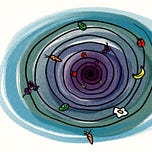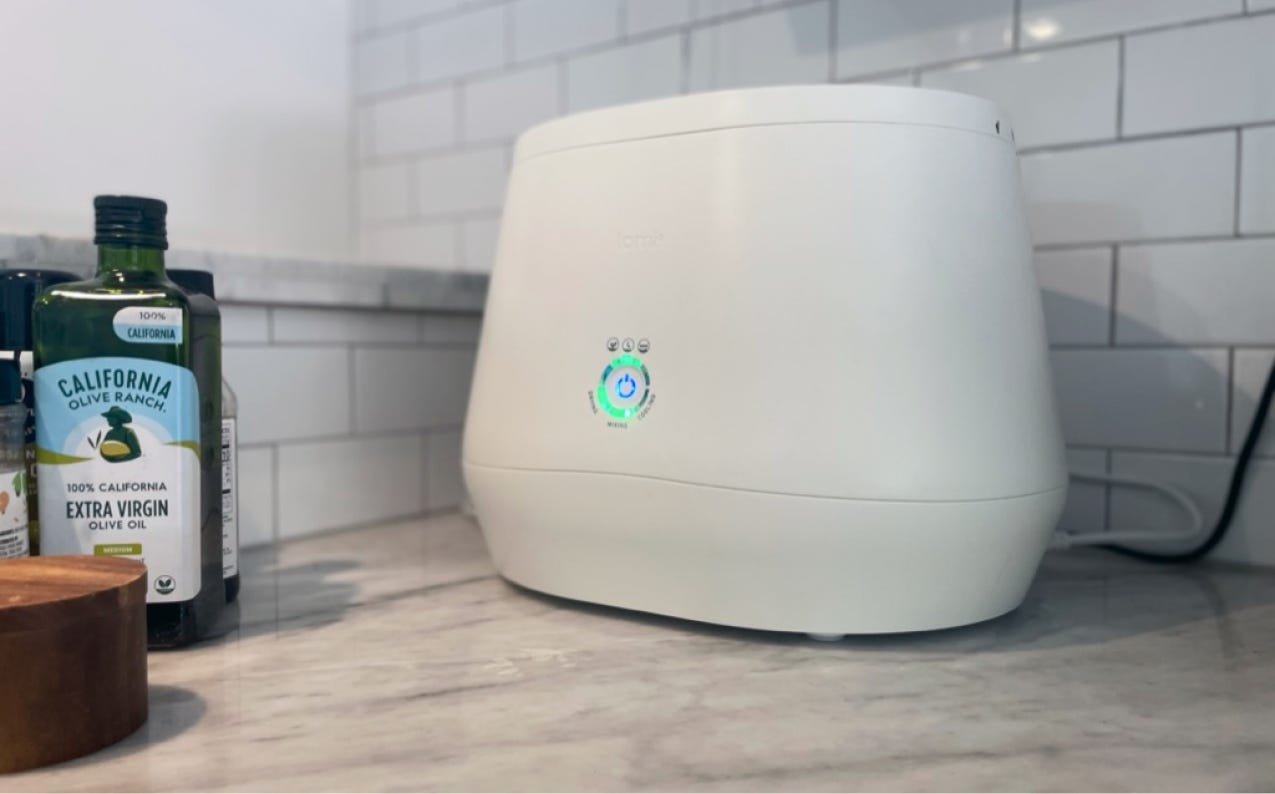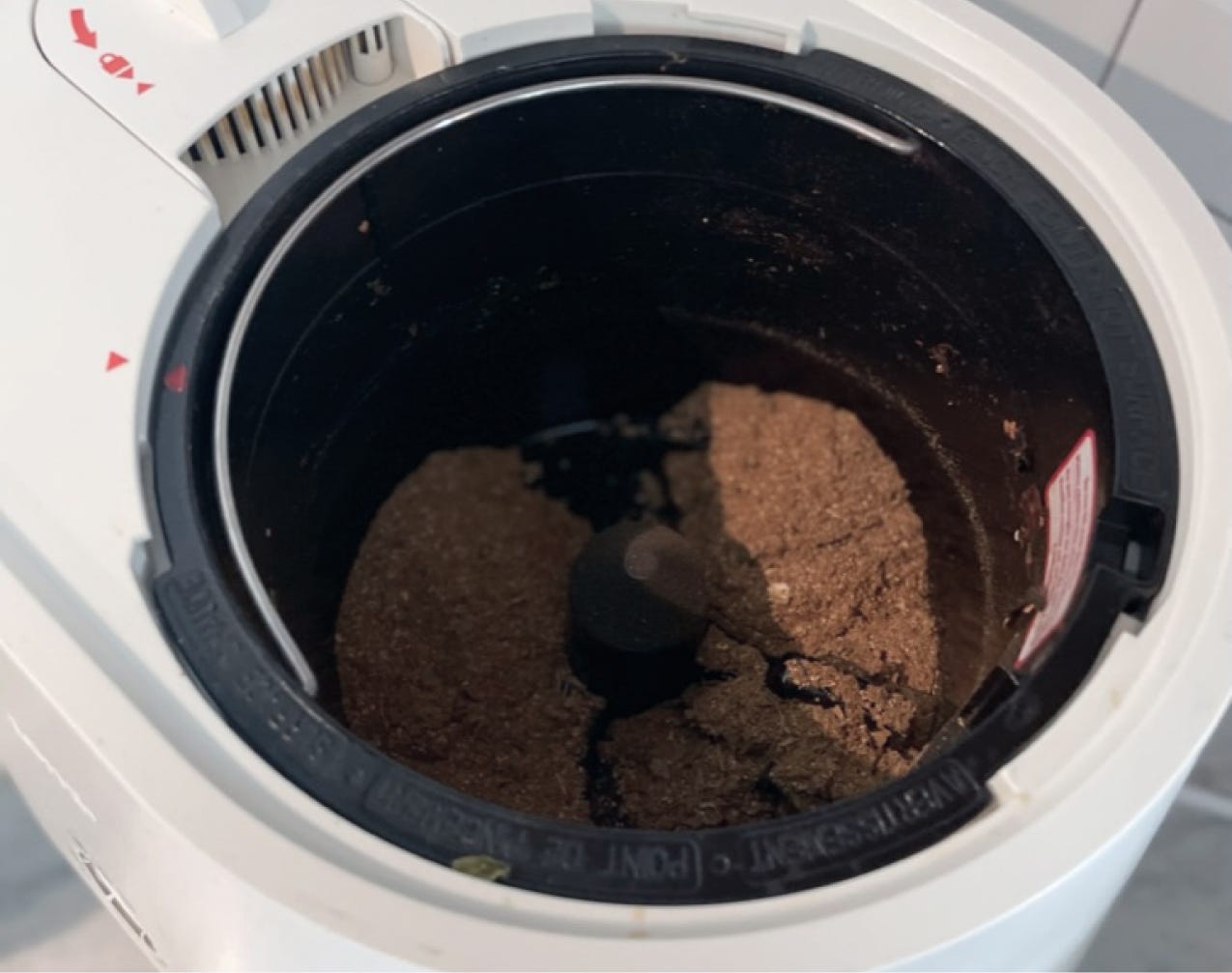👋 Good morning from Los Angeles! I'm Nate Kadlac, and this is #107 of Plan Your Next. A Sunday newsletter that connects design, creativity, and how you prepare for your next thing.
And on some occasions, I complain about composting. That’s next.
💡 What’s new?
🎨 Today is the last day to sign up for Approachable Design. Want to develop your own style and communicate your design decisions with confidence? I got you. But, there are only two spots left!
✏️ If you missed it last week, the recording and notes of our Drawing for Writers session are posted here. Here’s a first-hand experience from out a quick summary from a student here.
I can be a wasteful person.
But I want to be better. Rather than improve on this shortcoming, I bought a $300 kitchen composting machine to tell myself that at least I’m doing something.
Food waste is real, people. Especially with kids.
My daughter’s appetite is the dark matter of our family; it’s there, but I can’t begin to understand it in a meaningful way. I can’t predict it or manipulate it. Who knows how much or what it will crave on any given day.
I’m at its mercy.
See what I did there? I’ve already set the stage to defer my own garbage guilt onto a one-year-old who can’t even talk.
If we were serving her ice cream every day, nothing would go to waste, because I’d be willingly present to finish the scraps. But between broccoli, chicken, black beans, pasta, turkey, beets, and carrots, some days she wants more, some days less. Same as all of us. Right?
And that’s just the waste from someone who doesn’t even have a say in the matter.
My failed composting history
For the past eight years, my wife and I have lived in some pretty small apartments without a traditional way to compost. You know the ones: the large garbage bins that spin in the backyard, letting Mother Nature bring life back into your waste.
Living apartment to apartment in Los Angeles doesn’t give us that much space, so if you’re looking to virtue signal, your options are limited to the form of a pretty small tin can.
When we did compost, we used a small $20 stainless steel canister from Amazon. It fits about two and a half meals and requires custom compostable bags that never really fit. A simple Google search showed that using rubber bands around the top is how the DIYers do it, but they failed to mention how undoing a rubber band from an overflowing food waste container feels like dismantling a bomb.
The small bin would fill up every other day, forcing you to dutifully march back and forth between the compost bin and the kitchen. Dumping the sloshing pile of food scraps into a bigger bin inevitably leaves food waste on your hands or clothes.
This went on for a few years. Then along came our daughter. While I could blame everything on her, I won’t. But curiously, I haven't composted a damn thing since her arrival.
I’ll pause while you gasp.
The moment where I try to redeem myself
It’s now been about a year since I have lived shame, letting the small compost can from Amazon sit in the corner, unused out of pure laziness.
While searching online, I came across the $300 bucket called Lomi (I was a first adopter sucker who bought it during a presale—it’s $500 now!). I’m not sure why I decided this was a normal amount to spend to be viewed as a climate-conscious person, but I’m sure some part of it was trying to make up for the fact it had been almost a year of not composting. Of course, that was all my daughter’s fault.
But what really drew me into it was that you could compost your scraps down into healthy, nutrient-filled plant soil.
Being a mediocre plant dad, I suddenly thought I could make up for the lost time. I could compost my scraps, and feed my leafy green friends at the same time.
The apartment-sized Lomi compost bucket
What the Lomi does is break down food scraps—and bio-degradable packaging (!)—into nutrient-rich soil. And it does all of this on your kitchen counter, while plugged into an outlet. It’s fast-forwarding a natural process, kind of like when nature reveals organic matter decomposing at timelapse speed.
There are three settings to choose from. The first you can use for plant soil, where it takes a bit longer—24 hours—by using less heat and keeping the nutrients intact. They refer to the nutrient-rich soil as Black Gold.
The second setting is the default, which takes about 4-6 hours. The end result is still soil, it’s just not suitable for your plants.
The third setting is one that you can use for bioplastics. Even the Lomi packaging itself can be cut up and composted right inside the damn thing! (Because I’m horrible, I didn’t read about this setting until it was too late and everything was recycled.)
In all three modes, you end up with incredibly dry dirt you can safely walk out to your city-issued compost bin without the mess. Or in my case, to breathe new life into our potted plants.
Overall, it reduces the volume of food waste by up to 90%, so I can compost almost a week’s worth of scraps without walking it out. And it doesn’t smell because of the tight-fitting lid. Well, it smells, but like an armpit after not wearing deodorant for half a day.
With most of these tech gadgets, you always wonder about its shelf life, and if the thing breaks—which it inevitably will—it ends up being just a giant bin for food scraps like we originally had.
I honestly can’t predict what will happen, but they do tend to push the three years extended warranty for this, so I’m getting a bit nervous. If it ends up in a landfill, then I’m worse off than where I started. As of writing this, I have not researched whether I can buy a new Lomi and let it compost itself. I’ll file this as a feature request for the next software update.
While I may regret this decision later, it’s been fun to use in the same way that deleting an email is fun. You press a single button and the machine responds with a beep, signaling you’re doing a good thing. Then immediately, it starts to whir and gently fill the kitchen with a not-so-subtle white noise, grinding organic matter into Black Gold.
Aesthetically, it’s as if Apple designed the product, with its stark white exterior and shiny white power cable. The size is about twice the size of our old tin can, but it nestles nicely into the corner without being an eyesore.
But take my review with a grain of salt…
To give this not-so-serious review some authenticity, I asked my wife how she liked it.
“I’m not sure it’s worth it.”
I guess this is where I’ll promise to do a future update that never gets written, like my daughter’s appetite, which will be difficult to predict.
There you have it. Lomi—a gorgeous yet overpriced compost bucket that signals to everyone—and to myself—that you’re a better person. Pre-order now for $500*, a price increasingly outpacing national inflation levels. Ouch.
*Not affiliated in any way, especially after this review.
❤️ Much appreciated feedback help from Cam, Matt, Scott, Caryn, Florian, Sara, Katerina, and Chris.
⚡️ Your next creative hits
👨💻 Find the first version of anything
Before the next, there’s always a first. Pretty wild to see the first job posting from Jeff Bezos, the first video on YouTube, or the first bottle of Chanel N°5. H/T Sari Azout
👨💻 All icons start as squares
I’m sure most of you haven’t designed icons, but this thread brilliantly walks through how to make it more approachable. Most ideas for icons are simple enough to be created from existing shapes.
🟤 The Color of Water
What color do you think of when you see water? For many, it’s not blue. Unsplash and charity:water recently collaborated and showcased images based on different colors of water.
👋 See you next Sunday
If you’ve forgotten who I am, here’s a little bit about me. As always, my calendar is open to chat about your next adventure, crazy idea, or if you’re feeling creatively stuck.
Have a great week,
p.s. If you enjoyed this letter, would you please let me know by tapping on the heart below?.
















